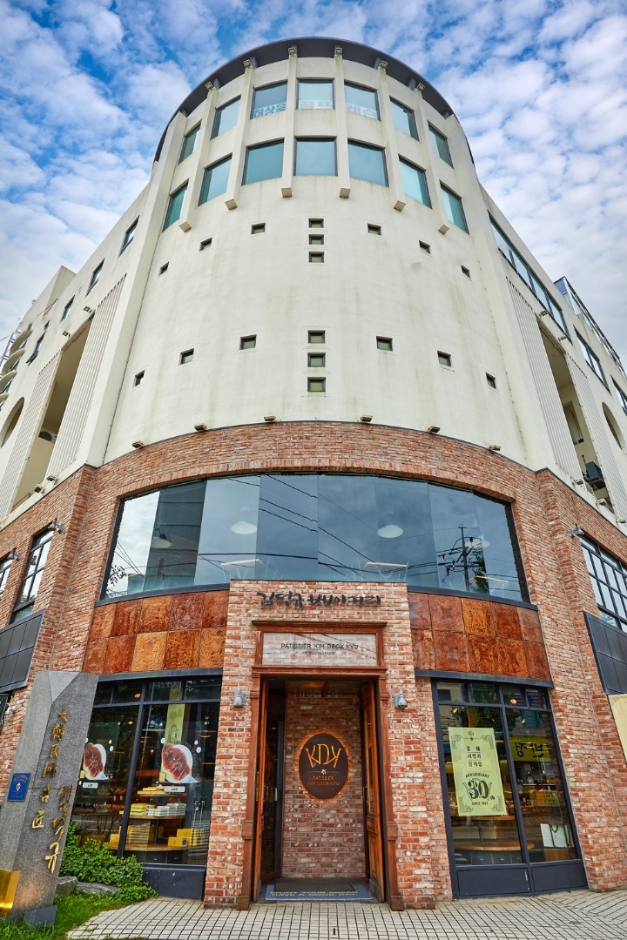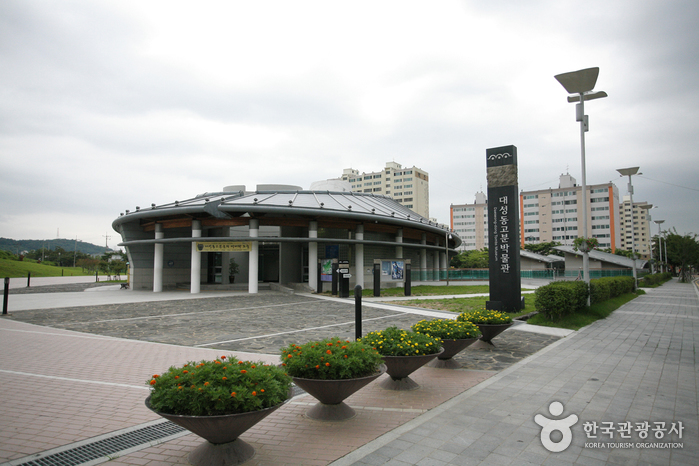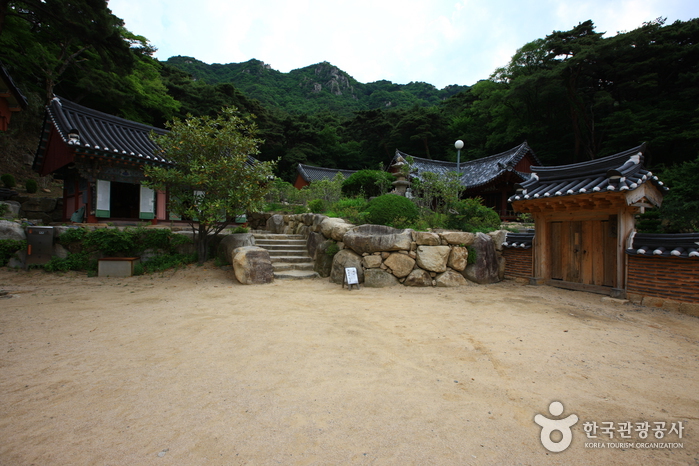Bunsanseong Fortress (김해 분산성)
2.6 Km 25717 2023-01-18
210-162, Gaya-ro 405beon-gil, Gimhae-si, Gyeongsangnam-do
+82-55-330-3925
Bunsanseong Fortress was constructed in the 3rd year of the reign of Goryeo's King U (1377) by Magistrate Park Wi to defend against foreign enemies, but it was destroyed during the Japanese invasion of 1592. The fortress we see today was reconstructed by Magistrate Jeong Hyeon-seok in the 8th year of the reign of Joseon's King Gojong (1871). However, it is estimated that it was first built during the days of Gaya. It is a temoe-style fortress with rocks piled up like a long band at the peak of Bunsan from which downtown Gimhae, Gimhae Plains, the Nakdonggang River and the South Sea are all in a single, panoramic view. Today, fortress walls remain stretching for some 900 meters on the slope towards the city and, inside the fortress, there are two gate sites in the south and north, an auxiliary gate on the west, a well site and several other building sites. The exact length of the remaining fortress walls is 929 meters and the average x_width is about 8 meters.
Inside the fortress lies Haeeunsa Temple, which was built to pay respects to Queen Heo of Garak who had come from the sea, according to stories. The temple also enshrines portraits of King Suro and Queen Heo that were painted during the Joseon dynasty. During the Japanese invasion of 1592, monk soldiers were stationed at this temple.
The fortress is more popularly called "Manjangdae" by Gimhae locals, and this name originated from the description, "A tall tower 10,000 (man) gil in x_height," granted by Daewongun in the Joseon dynasty for this advanced base that defeats Japanese invaders. A writing of "Manjangdae" written by Daewongun himself as well as his stamp are engraved on a rock behind a beacon that was restored in 1999.
Gimhae Gaya Country Club (가야컨트리클럽)
2.6 Km 8972 2020-06-24
502, Inje-ro, Gimhae-si, Gyeongsangnam-do
+82-55-337-0091
The Gimhae Gaya Country Club is a mammoth golf club featuring 6 courses with a combined total of 54 holes (45 holes for club members-only, 9 holes for use by the general public). Of the 6 courses (Sineo, Nakdong, Gimhae, Suro, Garak, and the public course), Sineo is the course that is said to have a ‘feminine touch’ since it features ancient groves of trees and natural landscaping. Nakdong, on the other hand, is said to be the most ‘masculine’ course due to its sheer size and cliffside location.
The Gimhae Gaya Country Club is operated in conjunction with Gaya Land, an entertainment facility, youth training center, swimming pool, tennis court, outdoor learning center, and campsite area.
Kim Deok-kyu Bakery (김덕규베이커리)
2.7 Km 0 2024-01-24
20 Guji-ro, Gimhae-si, Gyeongsangnam-do
Founded by Kim Deok-kyu, who is a recognized confectionery master, this bakery becomes crowded with people as early as 8 a.m. when it opens. The bakery’s most popular item among a lot of different breads is garlic cream bread, which everyone buys at least once. It is the most delicious one in this bakery, made by cutting a long plain bread into pieces and filling them with garlic cream of sweet condensed milk and soft whipped cream. The coconut milk bun, combined with crunchy biscuits and sweet and soft coconut cream, is also its best-seller..
Ancient Tombs in Daeseong-dong, Gimhae (김해 대성동 고분군)
3.0 Km 8390 2020-04-02
126, Gayaui-gil, Gimhae-si, Gyeongsangnam-do
+82-55-330-3934
The tumuli in Daeseong-dong, located to the east of the Royal Tomb of Kim Suro, reflect the formation and development of the Gaya Era. The Daeseong-dong Tumuli are located in the center of the shell mounds of Hoehyeon-ri, the location of the founding of the Gaya Kingdom according to local legend.
The tumuli relics were excavated by researchers from the Kyungsung University Museum from 1990 to 1992 and were found to be the common burial ground of the dominant class of the Gaya Kingdom. On the hilltops, which were viewed as prime burial places, are the tombs of kings and rulers; on the slopes are the tombs of the lower classes.
A total of 136 tumuli were found in the Daesong-dong area. Further investigation of the tumuli revealed several important and interesting facts. First, from the end of the third century, men and horses were buried alive along with the dead. Also, weapons were bent and buried as well, with many of these artifacts being unearthed among the tumuli. Other materials found in the tumuli such as cylindrical bronze items, pinwheel-shaped bronze items, and jasper items showed that Gaya was involved in trade with Japan. The Daeseong-dong Tumuli is significant in that it gives a glimpse into the political and social structure of the Gaya Kingdom, and the cultural exchange between Korea, China, and Japan.
Museum of the ancient tombs in Daseong-dong (대성동고분박물관)
3.2 Km 13723 2023-01-02
126, Gayaui-gil, Gimhae-si, Gyeongsangnam-do
+82-55-350-0401
The Museum of the ancient tombs in Daseong-dong displays artifacts unearthed from the four excavations of the Daeseongdong Tumuli. Highlighting often overlooked relics of the Geumgwan Gaya, the museum has three ground-floor exhibit halls and several underground auxiliary facilities. The main exhibits include a life-sized statue of a mounted soldier and a warrior statue, both recreated based on bones excavated from the tumuli of Yean-ri. The museum relies heavily on videos and dioramas to help visitors explore all the museum has to offer.
Tomb of King Suro (수로왕릉)
3.3 Km 16800 2024-01-23
26 Garak-ro 93beon-gil, Gimhae-si, Gyeongsangnam-do
+82-55-332-1094
King Suro founded the Garak Kingdom in AD 42 and married Heo Hwang-ok, a princess from the Indian country of Ayuta, in AD 48. He was the founder of the Gimhae Kim family. Heo Yeop, a Yeongnam governor, gave the tomb its current look in the 13th year of the reign of King Seonjo (1580). The tomb compound includes various buildings, including the Sungseonjeon (where the ancestral tablets of King Suro and his queen are kept), Anhyanggak, Jeonsacheong, and Jegigo, as well as stone structures, such as a sindobi (tombstone) and gongjeokbi (monument established to pay homage the deceased). The tombstone in front of the royal tomb was built in the 25th year of the reign of King Injo (1647) of the Joseon dynasty. The name Sungseonjeon was bestowed on the tomb by King Gojong in the 21st year of his reign (1884).
Sureungwon Garden (수릉원)
3.3 Km 8301 2024-01-23
35 Bunseong-ro 261beon-gil, Gimhae-si, Gyeongsangnam-do
Sureungwon Garden is a place themed around the meeting between King Suro, the founder of Gaya, and Queen Heo, who was the princess of Ayuta Kingdom, known as India. The name Sureungwon Garden also contains the meaning of an elegant forest where King Suro and Queen Heo walked together. An ecological park measuring 39,600 m2 has been created along a low ridge that connects the Tomb of King Suro, an important cultural heritage of the Gaya period; the Ancient Tombs in Daeseong-dong, the tombs of the Gaya kings; and the Bonghwang-dong Historic Site. It was created by representing the maritime kingdom of Gaya, imagining a pond of the garden where King Suro and Queen Heo used to walk, and planting prickly waterlilies and yellow floating hearts that are believed to have inhabited wetlands in the Gaya period. Trails along the cozy forest and pond make it easy to look around comfortably.
Olive Young - Inje Univ. Branch [Tax Refund Shop] (올리브영 인제대)
3.3 Km 0 2024-04-17
190, Inje-ro, Gimhae-si, Gyeongsangnam-do
-
Gimhae Eunhasa Temple (은하사(김해))
3.4 Km 14493 2021-02-24
167, Sineosan-gil, Gimhae-si, Gyeongsangnam-do
+82-55-337-0101
Eunhasa Temple is located in Sineosan Mountain in Gimhae, Gyeongsangnam-do. The year it was founded remains unknown, but legend has it that Monk Jangyuhwasang built the temple in AD 1, before the nationwide spread of Buddhism. However, relic pieces found at the temple site indicate the possibility of the temple's establishment in the Three Kingdoms Era. The temple was once burned down together with Dongnimsa Temple during the Imjin War and the architectural design seen today is that of the late Joseon dynasty.
Gimhae Korean-style house [Korea Quality] / 김해한옥체험관 [한국관광 품질인증]
3.4 Km 161 2023-10-25
40 , Wangneung-gil, Gimhae-si, Gyeongsangnam-do
+82-55-322-4735~6
The Hanok Experience Center in Gimhae, Gyeongsangnam-do, offers guests a taste of old-time hanok life. Rooms are furnished with traditional items, while the spacious wooden floor can be used as a meeting room. Rooms in the sarangchae are on the small side but have an upper floor with scenic views. The room in the annexe building has a traditional sleeping mat surrounded by a large folding screen, and feels like a scene from a historical drama. Each room has a modern bathroom, There is a traditional experience program, and information services in English and Japanese.




![Gimhae Korean-style house [Korea Quality] / 김해한옥체험관 [한국관광 품질인증]](http://tong.visitkorea.or.kr/cms/resource/81/3016981_image2_1.jpg)
 English
English
 한국어
한국어 日本語
日本語 中文(简体)
中文(简体) Deutsch
Deutsch Français
Français Español
Español Русский
Русский